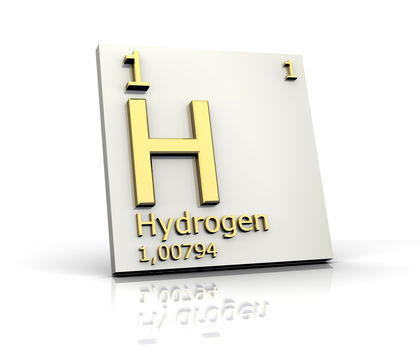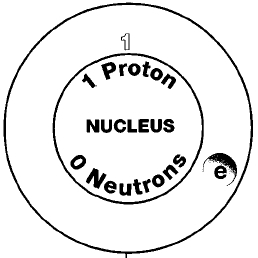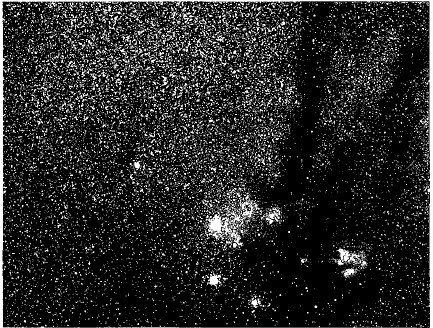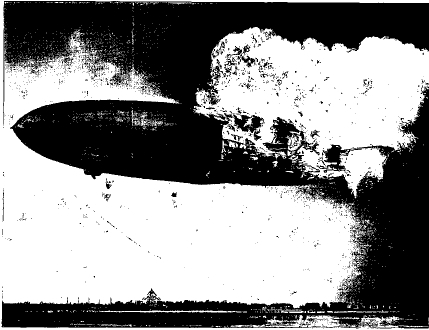HYDROGEN


Overview
Hydrogen is the most abundant element in the universe. Nearly nine out of every ten atoms in the universe are hydrogen atoms. Hydrogen is also common on the Earth. It is the third most abundant element after oxygen and silicon. About 15 percent of all the atoms found on the Earth are hydrogen atoms.
Hydrogen is also the simplest of all elements. Its atoms consist (usually) of one proton and one electron.
Hydrogen was first discovered in 1766 by English chemist and physicist Henry Cavendish (1731-1810). Cavendish was also the first person to prove that water is a compound of hydrogen and oxygen.
Some experts believe that hydrogen forms more compounds than any other element. These compounds include water, sucrose (table sugar), alcohols, vinegar (acetic acid), household lye (sodium hydroxide), drugs, fibers, dyes, plastics, and fuels.
SYMBOL
H
ATOMIC NUMBER
1
ATOMIC MASS
1.00794
FAMILY
Group 1 (IA)
PRONUNCIATION
HY-dru-jin
Discovery and naming
Hydrogen was probably "discovered" many times. Many early chemists reported finding a "flammable gas" in some of their experiments. In 1671, for example, English chemist Robert Boyle (1627-91) described experiments in which he added iron to hydrochloric acid (HCl) and sulfuric acid (H 2 SO 4 ). In both cases, a gas that burned easily with a pale blue flame was produced.
The problem with these early discoveries was that chemists did not understand the nature of gases very well. They had not learned that there are many kinds of gases. They thought that all the "gases" they saw were some form of air with impurities in it.
Cavendish discovered hydrogen in experiments like those that Boyle
performed. He added iron metal to different acids and found that a
flammable gas was produced. But Cavendish thought the flammable gas came
from the iron and not from the acid. Chemists later showed that iron is an
element and does not contain hydrogen or anything else. Therefore, the
hydrogen in Cavendish's experiment came from the acid:
Hydrogen was named by French chemist Antoine-Laurent Lavoisier (1743-94). Lavoisier is sometimes called the father of modern chemistry because of his many contributions to the science. Lavoisier suggested the name hydrogen after the Greek word for "water former" (that which forms water). (See sidebar on Lavoisier in the oxygen entry in volume 2.)
Physical properties
Hydrogen is a colorless, odorless, tasteless gas. Its density is the lowest of any chemical element, 0.08999 grams per liter. By comparison, a liter of air weighs 1.29 grams, 14 times as much as a liter of hydrogen.
Hydrogen changes from a gas to a liquid at a temperature of -252.77°C (-422.99°F) and from a liquid to a solid at a temperature of -259.2°C (-434.6°F). It is slightly soluble in water, alcohol, and a few other common liquids.
Chemical properties
Hydrogen burns in air or oxygen to produce water:

It also combines readily with other non-metals, such as
sulfur, phosphorus,
and the halogens. The halogens are the elements that make up Group 17
(VIIA) of the periodic table. They include
fluorine, chlorine, bromine, iodine,
and
astatine.
As an example:
Occurrence in nature
Hydrogen occurs throughout the universe in two forms. First, it occurs in
stars. Stars use hydrogen as a fuel with which to produce energy. The
process by which stars use hydrogen is known as fusion. Fusion is the
process by which two or more small atoms are pushed together to make one
large atom. In most stars, the primary fusion reaction that occurs is:
This equation shows that four hydrogen atoms are squeezed together (fused) to make one helium atom. In this process, enormous amounts of energy are released in the form of heat and light.
Hydrogen also occurs in the "empty" spaces between stars. At one time, scientists thought that this space was really empty, that it contained no atoms of any kind. But, in fact, this interstellar space (space between stars) contains a small number of atoms, most of which are hydrogen atoms. A cubic mile of interstellar space usually contains no more than a handful of hydrogen and other atoms.
Hydrogen occurs on the Earth primarily in the form of water. Every molecule of water (H 2 O) contains two hydrogen atoms and one oxygen atom. Hydrogen is also found in many rocks and minerals. Its abundance is estimated to be about 1,500 parts per million. That makes hydrogen the tenth most abundant element in the Earth's crust.
Hydrogen also occurs to a very small extent in the Earth's atmosphere. Its abundance there is estimated to be about0.000055 percent. Hydrogen is not abundant in the atmosphere because it has such a low density. The Earth's gravity is not able to hold on to hydrogen atoms very well. They float away into outer space very easily. Most of the hydrogen that was once in the atmosphere has now escaped into outer space.
Isotopes
There are three isotopes of hydrogen, hydrogen-1, hydrogen-2, and hydrogen-3. Isotopes are two or more forms of an element. Isotopes differ from each other according to their mass number. The number written to the right of the element's name is the mass number. The mass number represents the number of protons plus neutrons in the nucleus of an atom of the element. The number of protons determines the element, but the number of neutrons in the atom of any one element can vary. Each variation is an isotope.
The three isotopes of hydrogen have special names. Hydrogen-1 is sometimes called protium. It is the simplest and most common form of hydrogen. Protium atoms all contain one proton and one electron. About 99.9844 percent of the hydrogen in nature is protium.
The man who gave hydrogen its name, Antoine-Laurent Lavoisier, is sometimes called the father of modern chemistry.
Hydrogen-2 is known as deuterium. A deuterium atom contains one proton, one electron, and one neutron. About 0.0156 percent of the hydrogen in nature is deuterium.
The third isotope of hydrogen, hydrogen-3, is tritium. An atom of tritium contains one proton, one electron, and two neutrons. There are only very small traces of tritium in nature.
Tritium is a radioactive isotope. A radioactive isotope is one that breaks apart and gives off some form of radiation. Some radioactive isotopes (such as tritium) occur in nature. They can also be produced in the laboratory. Very small particles are fired at atoms. These particles stick in the atoms and make them radioactive. Tritium is a widely used isotope and is now made in large amounts in the laboratory.
Tritium is widely used as a tracer in both industry and research. A tracer is a radioactive isotope whose presence in a system can easily be detected. The isotope is injected into the system at some point. Inside the system, the isotope gives off radiation. That radiation can be followed by means of detectors placed around the system.
Tritium is popular as a tracer because hydrogen occurs in so many different compounds. For example, suppose a scientist wants to trace the movement of water through soil. The scientist can make up a sample of water made with tritium instead of protium. As that water moves through the soil, its path can be followed by means of the radioactivity the tritium gives off.
Tritium is also used in the manufacture of fusion bombs. A fusion bomb is
also known as a hydrogen bomb. In a fusion bomb, small atoms are squeezed
together (fused) to make a larger atom. In the process, enormous amounts
of energy are given off. For example, the first fusion bomb tested by the
United States in 1952 had the explosive power of 15 million tons of TNT. A
type of fusion bomb fuses tritium with deuterium to make helium atoms:
Stars use hydrogen as a fuel with which to produce energy.
Extraction
The obvious source for hydrogen is water. The Earth has enough water to
supply people's need for hydrogen. The problem is that it takes a
lot of energy to split a water molecule:
In fact, it simply costs too much to make hydrogen by this method. The cost of electricity is too high. So it is not economical to make hydrogen by splitting water.
A number of other methods can be used to produce hydrogen, however. For
example, steam can be passed over hot charcoal (nearly pure
carbon):
The same reaction can be used with steam and other carbon compounds. For
example, using methane, or natural gas (CH
4
), the reaction is:
Hydrogen can also be made by the reaction between carbon monoxide (CO) and
steam:
Because hydrogen is such an important element, many other methods for producing it have been invented. However, the preceding methods are the least expensive.
Uses
The most important single use of hydrogen is in the manufacture of ammonia
(NH
3
). Ammonia is made by combining hydrogen and nitrogen at high pressure and
temperature in the presence of a catalyst. A catalyst is a substance used
to speed up or slow down a chemical reaction. The catalyst does not
undergo any change during the reaction:
Ammonia is a very important compound. It is used in making many products, the most important of which is fertilizer.
Hydrogen is also used for a number of similar reactions. For example, it
can be combined with carbon monoxide to make methanol—methyl
alcohol, or wood alcohol (CH
3
OH):
Tritium (hydrogen-3, the third isotope of hydrogen), is used in the manufacture of fusion bombs.
Like ammonia, methanol has a great many practical uses in a variety of industries. The most important use of methanol is in the manufacture of other chemicals, such as those from which plastics are made. Small amounts are used as additives to gasoline to reduce the amount of pollution released to the environment. Methanol is also used widely as a solvent (to dissolve other materials) in industry.
Another important use of hydrogen is in the production of pure metals.
Hydrogen gas is passed over a hot metal oxide to produce the pure metal.
For example,
molybdenum
can be prepared by passing hydrogen over hot molybdenum oxide:
The Hindenburg explosion
T he Hindenburg was Germany's largest passenger airship. It was built in 1936 as a luxury liner, and made the trip to the United States faster than an ocean liner.
The Hindenburg was designed to be filled with helium, a safer gas than the highly flammable hydrogen. But in those post-World War II days, the United States suspected that Germany's new leader, Adolf Hitler (1889-1945), had military plans for helium-filled ships. So the United States refused to sell helium to the Zeppelin air-ship company. Seven million cubic feet of hydrogen was used instead. This made the crew very nervous about the potential for fire. Passengers were even checked for matches as they boarded!
On May 3, 1937, the Hindenburg left Frankfurt, Germany, for Lakehurst, New Jersey. It travelled over the Netherlands, down the English Channel, through Canada, and into the United States. Bad weather forced the ship to slow down several times, lengthening the trip. But it finally approached the field in Lakehurst around 7:00 P.M. on May 6.
After several minutes of maneuvers due to rain and wind, crewmen dropped ropes to the ground at 7:21. The ship was 200 feet above ground. Four minutes later, a small flame emerged on the skin of the ship, and crewmen heard a pop and felt a shudder. Seconds later, the Hindenburg exploded. Flaming hydrogen blasted out of the top. Within 32 seconds, the entire airship had burned, the framework had collapsed, and the entire ship lay smoldering on the ground. Thirty-six people died. Amazingly, 62 survived.
Although claims of sabotage have always surrounded the Hindenburg tragedy, American and German investigators both agreed it was an accident. Both sides concluded that the airship's hydrogen was ignited probably by some type of atmospheric electric discharge. Witnesses had noticed some of the skin of the ship flapping; they also observed the nose of the ship rise suddenly. Both indicate the likelihood that free hydrogen had escaped. The Hindenburg disaster ended lighter-than-air air-ship travel for many decades.
Hydrogenation is an important procedure to the food industry. In hydrogenation, hydrogen is chemically added to another

Hydrogen is also used in oxyhydrogen ("oxygen + hydrogen") and atomic hydrogen torches. These torches produce temperatures of a few thousand degrees. At these temperatures, it is possible to cut through steel and most other metals. These torches can also be used to weld (join together with heat) two metals.
Another use for hydrogen is in Lighter-than-air balloons. Hydrogen is the least dense of all gases. So a balloon filled with hydrogen can lift very large loads. Such balloons are not used to carry people. The danger of fire or explosion is too great. On May 6, 1937, a hydrogen fire destroyed the German airship Hindenburg, as it was landing in Lakehurst, New Jersey; 36 people died. Today, hydrogen balloons are used for lifting weather instruments into the upper atmosphere.
One of the best known uses of hydrogen is as a rocket fuel. Many rockets obtain the power they need for lift-off by burning oxygen and hydrogen in a closed tank. The energy produced by this reaction provides thrust to the rocket.
Solving the world's energy problems
M ost people don't worry about filling their cars with gas. They seem to believe that there will always be enough coal, oil, and natural gas to keep civilization running. Those three fuels—the "fossil fuels"—are what keep people on the move today. They fuel cars and trucks, heat homes and offices, and keep factories operating.
But fossil fuels will not last forever. At some point, all the coal, oil, and natural gas will be gone. What source of energy will humans turn to?
Some people believe that hydrogen is the answer. They talk about the day when the age of fossil fuels will be replaced by a hydrogen economy.
"Hydrogen economy" refers to a world in which the burning
of hydrogen will be the main source of energy and power. Hydrogen seems
to be a good choice for future energy needs. When it burns, it produces
only water:
A lot of energy is produced in this reaction. That energy can be used to operate cars, trucks, trains, boats, and airplanes. It can be used as a source of heat for keeping people warm and running chemical reactions.
Why doesn't a hydrogen economy exist today? The answer is easy. It is still too expensive to make hydrogen gas. No one has found a way to remove hydrogen from water or some other source at a low cost. It is still cheaper to mine for coal or drill for oil than to make hydrogen.
But that may not always be true. Some day, someone will find a way to make hydrogen cheaply. When that happens, the day of the hydrogen economy will have arrived.
Compounds
Millions of hydrogen compounds are known. One of the most important groups of hydrogen compounds is the acids. An acid is any compound that contains hydrogen as its positive part. Common acids include: hydrochloric acid (HCl), sulfuric acid (H 2 SO 4 ), nitric acid (HNO 3 ), acetic acid (HC 2 H 3 O 2 ), phosphoric acid (H 3 PO 4 ), and hydrofluoric acid (HF).
Acids are present in thousands of natural substances and artificial products. The following list gives a few examples: vinegar, or acetic acid (HC 2 H 3 O 2 ); sour milk, or lactic acid (C 3 H 6 O 3 ); lemons and other citrus fruits, or citric acid (C 6 H 8 O 7 ); soda water, or carbonic acid (H 2 CO 3 ); battery acid, or sulfuric acid H 2 SO 4 ); and boric acid (H 3 BO 3 ).
Health effects
Hydrogen is essential to every plant and animal. Nearly every compound in a living cell contains hydrogen. It is harmless to humans unless taken in very large amounts. In this case, it is dangerous only because it cuts off the supply of oxygen humans need to breathe.